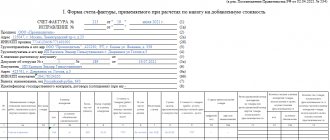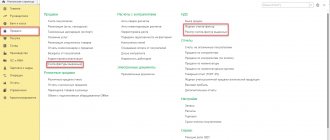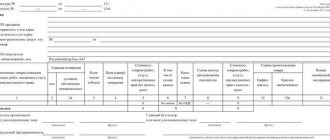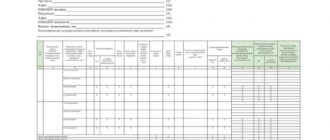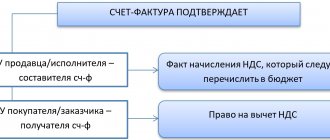What is an account
The term “Invoice” is used when there is a need to pay for goods or services. As a rule, after shipment of sold products or completion of work or services, the seller presents an invoice to the buyer. The latter receives the document and makes payment according to the prices indicated in it.
The account itself is not recognized as a primary accounting document, since it does not reflect the fact of transactions. With its help, the seller only informs the buyer of his desire to receive payment.
In turn, the completion of a business transaction is recognized as the fact that the buyer transfers funds according to the invoice. However, this type of option is formalized by other papers, for example, a receipt order or a bank statement.
An invoice is needed to provide the buyer with payment details, as well as to remind the buyer to make a payment.
Invoice: concept
An invoice is a document indicating the shipment of goods, performance of work, and provision of services. It is drawn up by the contractor and sent to the customer. Based on it, the latter makes payment.
An invoice is required for tax accounting. It is used to calculate VAT. Based on this document, the amount of deduction when paying value added tax is calculated. The thing is that tax legislation provides for a rule for reducing the volume of tax liabilities by the amount of VAT submitted.
It should be noted that the document is drawn up on a standardized form. Otherwise, the tax office will not accept the paper as a legal justification for expenses.
If some fields are left empty, then a dash must be placed in them. It happens that several lines in a row are not filled in at once. This can happen if the document is drawn up manually on a pre-printed form. Then all fields are crossed out with a capital Latin letter “Z”.
It should be noted that it is prohibited to put a dash in the columns that indicate the name of the customer, contractor, as well as the unit of measurement.
Differences between an invoice and an invoice
Invoice and invoice are terms that have different wording, despite their similar sound.
An invoice is a document sent to the customer, which contains details for payment for goods, services, works received and their cost. The account itself has no requirements. It can be easily canceled, since it is not subject to mandatory accounting.
The difference between an invoice and an invoice is that the former is used for tax accounting. It is by the presence of this document that the taxpayer has the right to confirm the legality of the declared deductions for previously paid value added tax.
Difference between an invoice and an invoice
What type of invoice?
How the invoice is inclined , we figured it out. It remains to determine what kind of word this is: masculine or feminine?
In accordance with the rules of the Russian language, when determining the gender of a complex compound word, the gender of its leading component is taken into account. Usually the leading word in complex compound words comes at the beginning of the construction.
When determining the leading component in a complex word, you can use the following approach. Thus, the leading word is the broadest concept of a given term, and the auxiliary word only denotes its characteristic difference. Thus, in the complex word “invoice”, the leading word, without a doubt, is “account” - this word generalizes the type of primary accounting documents. And part of the complex compound word “invoice” (translated from Latin facturo - processing) determines the special form of this particular document used in tax accounting.
We conclude that the complex compound word “invoice” is masculine. After all, the leading word “count”, which appears at the beginning of a complex construction, is masculine.
Accordingly, when declension of the complex word “invoice”, it should be taken into account that it is masculine. Thus, it is completely incorrect to use phrases such as “invoice issued” or “invoice received (changed, corrected)”, etc.
Those who not only believe that the word “invoice” is feminine, but also prefer not to inflect the first part of the complex construction are doubly wrong. The following phrases are quite annoying to the ears of not only a legally savvy, but also a simply literate person: “I didn’t receive your invoice, so duplicate it.” Correctly, this phrase would sound like this: “I did not receive your invoice, so duplicate it.”
Examples of the correct use of the word “invoice” in the text can be found in the Tax Code (Article 169 is devoted to this concept), as well as in a number of government regulations. Thus, the invoice form was approved by Resolution No. 1137 of December 26, 2011, as amended this year. In addition, the term “invoice” is often used in arbitration courts when considering disputes between taxpayers and fiscal authorities.
Term as part of speech
Sometimes, due to their illiteracy, people mistake the word “invoice” for a phrase or set of words. However, this is absolutely not true. Invoice is a compound word that consists of two concepts.
Important! According to existing rules, compound words are written with a hyphen. When inflecting a term, it is necessary to transform both the main and the dependent word.
It is incorrect to decline only one of the parts of a compound word. In oral speech, a similar approach to modifying forms is used quite often, but in writing these mistakes should be avoided.
Gender: masculine, feminine or neuter
To determine the gender of any word, you need to put one of the possessives “My”, “My”, “My” in front of it.
The first means that the word is masculine, the second – feminine, and the third – neuter.
The term "invoice" consists of two words that have different genders. The word “account” (my account) is masculine, and “invoice” (my invoice) is feminine.
The complex concept of “invoice” itself is masculine. The thing is that the gender of compound words consisting of two or more terms is determined by the main one.
In our case, the main word is “invoice”, and the subordinate word is “invoice”. Due to the fact that “invoice” is masculine, the “invoice” is also masculine.
Examples
- An invoice for Mega-Land LLC was issued today.
- The invoice has been sent to the payer.
- The invoice from Trans-Service LLC was lost.
- The invoice does not have the supplier's signature.
- I don't see an invoice from you in my email.
Thus, invoice is masculine, as evidenced by the gender of the main word “invoice”.
What type of invoice?
How the invoice is inclined , we figured it out. It remains to determine what kind of word this is: masculine or feminine?
In accordance with the rules of the Russian language, when determining the gender of a complex compound word, the gender of its leading component is taken into account. Usually the leading word in complex compound words comes at the beginning of the construction.
When determining the leading component in a complex word, you can use the following approach. Thus, the leading word is the broadest concept of a given term, and the auxiliary word only denotes its characteristic difference. Thus, in the complex word “invoice”, the leading word, without a doubt, is “account” - this word generalizes the type of primary accounting documents. And part of the complex compound word “invoice” (translated from Latin facturo - processing) determines the special form of this particular document used in tax accounting.
We conclude that the complex compound word “invoice” is masculine. After all, the leading word “count”, which appears at the beginning of a complex construction, is masculine.
Accordingly, when declension of the complex word “invoice”, it should be taken into account that it is masculine. Thus, it is completely incorrect to use phrases such as “invoice issued” or “invoice received (changed, corrected)”, etc.
Those who not only believe that the word “invoice” is feminine, but also prefer not to inflect the first part of the complex construction are doubly wrong. The following phrases are quite annoying to the ears of not only a legally savvy, but also a simply literate person: “I didn’t receive your invoice, so duplicate it.” Correctly, this phrase would sound like this: “I did not receive your invoice, so duplicate it.”
Examples of the correct use of the word “invoice” in the text can be found in the Tax Code (Article 169 is devoted to this concept), as well as in a number of government regulations. Thus, the invoice form was approved by Resolution No. 1137 of December 26, 2011, as amended this year. In addition, the term “invoice” is often used in arbitration courts when considering disputes between taxpayers and fiscal authorities.
Changing the form of a word depending on case
The term “Invoice” can only be declined by cases. As a rule, the procedure is carried out by putting the initial form of the word into another, answering the question corresponding to the case.
There are 6 cases in Russian:
- nominative (hereinafter referred to as IP);
- genitive (hereinafter referred to as RP);
- dative (hereinafter referred to as DP);
- accusative (hereinafter referred to as DP);
- instrumental (hereinafter TP);
- prepositional (hereinafter PP).
The initial form of any word corresponds to the nominative case (hereinafter referred to as IP). That is, the IP for the invoice will sound like “invoice”.
General rules for declension
According to the rules of the Russian language, in order to decline a noun, it is necessary to put a subordinate word and a question before it. For example, the word house has the following forms: house (what?), home (what?), home (what?), house (what?), home (what?), about the house (about what?).
One
To understand how the word “invoice” changes depending on the case, let’s try to decline it in the singular.
| Case | Application example | The end of the first part of the word | The end of the second part of the word |
| IP | I have an INVOICE. | zero | -ah-ah |
| RP | I don't have an INVOICE . | -A- | -s- |
| DP | The INVOICE number is twenty. | -u- | -e- |
| VP | I found an INVOICE in the accounting department. | zero | -u- |
| TP | We identify costs BY INVOICE. | -om- | -e- |
| PP | Now we will talk about the INVOICE. | -e- | -e- |
That is, when inflecting the term “invoice” according to cases, it is necessary to substitute an additional word and a question in front of it.
Some
In order to talk about several documents, the singular number of the term “invoice” is converted into the plural. For example, I put invoices in a separate folder.
| Case | Application example | The end of the first part of the word | The end of the second part of the word |
| IP | I received four INVOICES . | -A- | -s- |
| RP | I don't have INVOICES. | -ov- | zero |
| DP | There are strict requirements for INVOICES | -am- | -am- |
| VP | I sent you INVOICES via messenger. | -A- | -s- |
| TP | The presence of justifications can be confirmed by INVOICES . | -ami- | -ami- |
| PP | It is impossible not to talk about INVOICES . | -Oh- | -Oh- |
That is, the transformation of multiple forms is implemented according to general rules. First, one part of the word is declined according to cases, then the second. Thus, the plural of the term has the following word forms:
Important! Regardless of the modification of the initial form of the term, it is written with a hyphen. The sign does not disappear even if the word is put into the plural or in the process of declension by case.
Invoice: declination
It is not surprising that accountants often make mistakes when using the word “invoice” in speech and writing cover letters. Moreover, it is especially often incorrectly inclined. So, many people prefer to leave the first part of a compound word unchanged. But it's not right.
When declension of a complex compound word, only that part of it remains unchanged, which does not wander separately. An example of such a word: cocoa beans. The word “cocoa” is not declined in Russian, therefore, even when the compound word in which it is included remains unchanged even when declined. But in our case, in the compound word “invoice”, the first part – “invoice” – is still declined. That is, according to the rules of grammar, both components of the word “invoice” are declined.
So, for example, it is correct to write:
- I sent an invoice. (Accusative).
- Invoice received. (Nominative case).
- An error has been detected on the invoice. (Prepositional).
- I didn't receive an invoice from you. (Genitive).
- Questions may arise regarding this invoice. (Dative).
- Rules for working with electronic invoices. (Instrumental case).
When using the word “invoice” in the plural, the rules for using this name remain the same. Examples of declension of a term in the plural:
- The invoices sent were completed with errors. (Nominative case, plural).
- These invoices are missing. (Genitive case, plural).
- You should look into the invoices of this individual entrepreneur. (Dative case, plural).
- I issued all invoices to you on time - expect by mail. (Accusative case, plural).
- What will happen to invoices next year? (Cruitive case, plural).
- You need to read the regulations about invoices. (Prepositional case, plural).
The word “invoice” in the nominative case should answer the question “what?”, in the genitive – “what?”, in the dative – “what?”, in the accusative – “what?”, in the instrumental – “what?” and in the prepositional – “about what?”.
An example of the declension of a term in phrases in practice
Let's assume a situation where the parties are discussing an invoice or several documents. In order not to seem illiterate, you need to learn how to correctly inflect a term in the singular and plural. To do this, it is important to understand how word forms are used in real life.
Singular
First of all, we will give an example of phrases where the word “invoice” appears in the singular.
- INVOICE is one of the main documents used for tax accounting. In this case, the term has an initial form and a nominative case.
- We do not have an INVOICE from . The fact that a genitive word is used in a sentence is indicated by the subordinate “no,” and the question “what?” can be asked about the term itself.
- The accountant assigned the INVOICE number ten - the dative case. The accountant (who?) assigned (what did?) the invoice (what?) number (what?) ten (which?).
- The manager says that he saw the INVOICE you need in the sales department. In this case, “invoice” is put in the accusative case.
- The manager will come today to pick up the INVOICE that is on the table. The fact that the word in the instrumental case is indicated by the question “with what?” with the subordinate preposition “for”.
- Today we will talk about the INVOICE given to us by Les-Komplekt LLC - prepositional case.
Often, when inflecting words in practice, people get confused and put the term in the wrong form. To avoid this, mentally ask yourself a question and answer it, bringing all parts of a compound term to the desired form.
Invoice: declination
It is not surprising that accountants often make mistakes when using the word “invoice” in speech and writing cover letters. Moreover, it is especially often incorrectly inclined. So, many people prefer to leave the first part of a compound word unchanged. But it's not right.
When declension of a complex compound word, only that part of it remains unchanged, which does not wander separately. An example of such a word: cocoa beans. The word “cocoa” is not declined in Russian, therefore, even when the compound word in which it is included remains unchanged even when declined. But in our case, in the compound word “invoice”, the first part – “invoice” – is still declined. That is, according to the rules of grammar, both components of the word “invoice” are declined.
So, for example, it is correct to write:
- I sent an invoice. (Accusative).
- Invoice received. (Nominative case).
- An error has been detected on the invoice. (Prepositional).
- I didn't receive an invoice from you. (Genitive).
- Questions may arise regarding this invoice. (Dative).
- Rules for working with electronic invoices. (Instrumental case).
When using the word “invoice” in the plural, the rules for using this name remain the same. Examples of declension of a term in the plural:
- The invoices sent were completed with errors. (Nominative case, plural).
- These invoices are missing. (Genitive case, plural).
- You should look into the invoices of this individual entrepreneur. (Dative case, plural).
- I issued all invoices to you on time - expect by mail. (Accusative case, plural).
- What will happen to invoices next year? (Cruitive case, plural).
- You need to read the regulations about invoices. (Prepositional case, plural).


